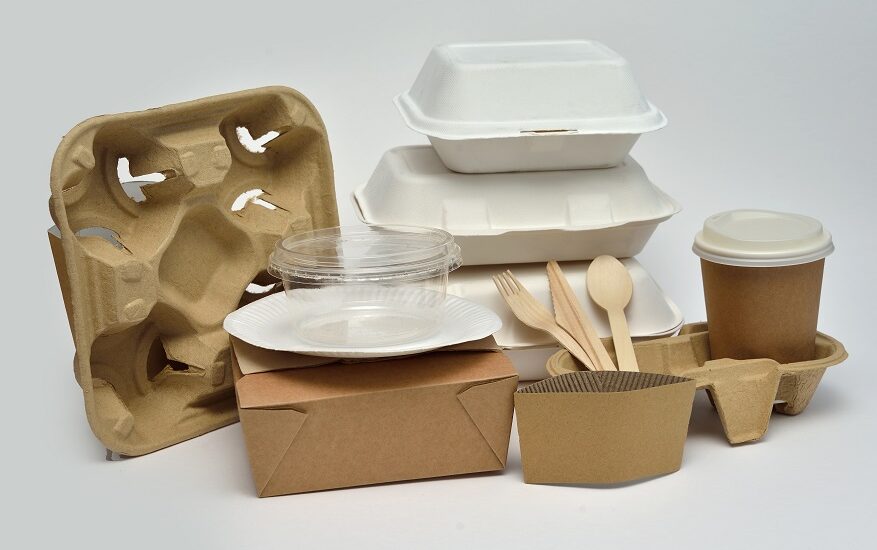According to Future Market Insight, the global market for compostable foodservice packaging is forecast to reach US$ 18.9 billion in 2023 and accelerate at a moderate CAGR of 4.5% during the assessment period (2023 to 2033). Overall compostable foodservice packaging sales are predicted to total a valuation of US$ 29.3 billion by 2033.
Rising demand for eco-friendly and sustainable packaging solutions across diverse end-use industries to reduce environmental pollution levels is a key factor driving the global compostable foodservice packaging market forward.
Similarly, rising awareness levels, the growing need for achieving the sustainability goal among the brands, and the implementation of stringent government regulations on the usage of single-use plastic products are expected to push the demand for compostable food service packaging.
Rising industry standards and the introduction of technology solutions into the paper market are creating future growth prospects for the compostable food service packaging market.
Initially, waste was generated by paper producers due to a lack of adequate paper-making machinery. Owing to technological advancements, waste created may now be repurposed as a raw material for creating paper or other products, which was previously not feasible due to a lack of required technologies.
Request Sample Report @ https://www.futuremarketinsights.com/reports/sample/rep-gb-3210
Wastage during the papermaking process has been cut in half as a result of the development of cutting-edge paper production technology, and paper producers’ efficiency has grown. In addition, technologically improved papermaking equipment give paper manufacturers increased production capacities.
Bagasse is expected to act as a revolutionary element in the compostable packaging market due to its strong, lightweight, affordable, and eco-friendly features. Bagasse is a dry, pulpy, fibrous by-product of crushed sugarcane. It is extensively utilized in the production of food packaging and service elements. It is completely biodegradable and has no harmful effects on the environment.
Bagasse packaging solutions can handle both hot and cold foods. Government restrictions on single-use plastics could make way for eco-friendly packaging solutions such as bagasse tableware. This in turn will boost the global compostable foodservice packaging industry.
With plastics becoming one of the biggest challenges in the world right now, brands prolifically using such materials will need to act quickly to find reliable alternatives. Technological innovations are being made to reduce the price of compostable foodservice packaging, and FMI’s study assesses that the global efforts to become a more sustainable society will be instrumental in creating new growth opportunities for the market vendors.
Trays Continue to Gain Preference Over Other Packaging Format
According to the study, the composite foodservice packaging market is estimated to grow at a CAGR of approximately 5% through 2029. One of the key growth drivers is a notable spike in the number of quick service restaurants (QSRs), especially in developing countries, which align with todays’ convenience and on-the-go culture. In addition, surging adoption of foodservice disposables, in the view of an increase in the demand for pre-packed food, has been preparing the grounds for compostable foodservice packaging penetration.
The study finds that compostable trays continue to account for relatively large share of manufacturers’ bottom lines, while more focus has been placed on increasing the production of compostable cups, as the category is witnessing rising demand from a multitude of end-use sectors. As the search for sustainable solutions scales up, companies operating in packaging industry are starting to launch a number of products made entirely from plant-based materials including mushroom roots, bagasse, seaweed, and starch derived from maize.
As per the study, the wave of ‘customization’ is also approaching in the compostable foodservice packaging space. To fulfill the individual packaging needs while promoting sustainability, manufacturers are targeted towards offering custom products of all sizes, ensuring food safety and minimizing leakage. Demand from non-chain restaurants continues to influence growth strategies, and as identified by the FMI’s study, market stakeholders are tapping into opportunities in chain café and independent foodservice operators. Rapid expansion of international chain café in developing countries along with growing consumer preference to eat out, especially from food trucks and street stalls, is also likely to work well with the manufacturers’ growth strategies.
Growth prospects of the compostable foodservice packaging, as the report opines, are high in EU5 and the U.S. Greater awareness and easy access to innovative solutions along with favorable regulatory framework and higher availability of compost facilities in these regions have worked to the advantage of the stakeholders. In addition, market consolidation in Asia Pacific, particularly in the southern region, will remain a key to gaining distinct competitive advantage, as trends of eating out and online ordering have spiked across the region.
The business intelligence report also offers an incisive outlook on competitive landscape by analyzing the key development strategies of the market players. According to the study, the market shows a high level of consolidation, with local and regional players catering to domestic and urgent demands, while leading players with strong regional presence account for relatively small share in the market.
However, markets such as Australia and other Oceanic countries, have witnessed a decline in sales of beer, mostly due to changes in consumption pattern and shift in consumer preference towards other alcoholic beverages. Despite the tough competition faced by beer from different alcoholic beverages, the rise in beer consumption in developing economies such as South Africa, Mexico, and India, is expected to drive the growth of the growlers market during the forecast period.
The primary factors driving the growth of growlers market is the changing consumer demand to experience a large variety of taste and flavors. Moreover, governments in various countries (Oregon being one of the pioneers) are promoting the use of growlers to promote safe storage of alcoholic beverages.
Get In Touch With Our Team For 20% Flat Discount
Key Takeaways from Compostable Foodservice Packaging Market
- By material type, paper & paperboard segment is expected to expand at 5.5% CAGR during the forecast period.
- The molded fiber sub-segment of paper & paperboard category is projected to register a CAGR of 6.9% between 2023 to 2033 due to its 100% biodegradable and compostable feature.
- Based on product type, cups and trays segments collectively are estimated to account for around 48% of the market value share by the end of 2033.
- By end use, delivery catering segment is anticipated to expand at 1.6 times the current market value during the forecast period.
- Western Europe holds a significant portion of the global compostable foodservice packaging industry owing to the presence of strict recycling laws.
- The USA compostable foodservice packaging market is forecast to create a growth opportunity of US$ 582.7 million during the assessment period.
- Demand for compostable foodservice packaging across Germany is poised to increase at 3.1% CAGR throughout the forecast period.
“A gradual shift from plastic foodservice packaging to greener material-based paper foodservice packaging has been witnessed in the past year. Biodegradable materials such as wood, corn starch, etc. offer sustainability added with proper packaging. Therefore, they have become ideal for making foodservice packaging,” says an FMI analyst.
Increased Consumption of Pre-Packaged Food Augmenting Sales of Compostable Foodservice Packaging
Pre-packaged food is packed food whose contents cannot be accessed without tampering with the package, which makes it a safe and hygienic food choice for customers. Factors like convenience, lower prices, busy lifestyles, and low effort are responsible for the growth of pre-packaged and ready-to-eat food, which is shaping the compostable foodservice packaging market.
Pouches and sachets are highly suited to pre-packaged food. The rise in portion-size food packs and healthy packaged foods is shaping the growth of pre-packaged foods. High-end machines and fast food processing and packaging equipment are responsible for the fast-paced growth of packaged food.
FMCG companies are hopping on the RTE (ready-to-eat) bandwagon and providing healthier varieties of existing snacks like cookies, chips, and candy. This is increasing the demand for pre-packaged food. The preference of customers for hygienic packaging is making brands shift towards more sustainable packaging materials. A recent example could be aseptic carton ready-to-drink beverages and replacing plastic straws with paper straws.
Rapid Expansion of Foodservice Industry to Boosting Compostable Foodservice Packaging Market
One of the most thriving and dynamic industries in the world is the foodservice industry. The sector has already unmatched growth, and it continues to generate revenue and create potential jobs. The development of the food production sector and the popularity of portable meals has improved the foodservice packaging sector.
The market for foodservice packaging is being further stimulated by the changing demographics and the increased internet usage among Generation Z. As more young people consume healthy, high-quality food that is packaged in hygienic ways, adoption of packaging solutions such as compostable cups, bowls, trays, etc. is increasing rapidly across foodservice industry.
Ask An Analyst @ https://www.futuremarketinsights.com/askus/rep-gb-3210
The bottom-up and top-down approaches have been used to estimate the Compostable Foodservice Packaging market by type, end-use industry and region. The research methodology is used to calculate the market size includes the following steps:
The size of the Compostable Foodservice Packaging market has been derived from the aggregation of the market shares of the leading players for each product, and the forecast is based on the analysis of market trends, such as pricing and consumption of Compostable Foodservice Packaging in various end-use industries.
The key players in the Compostable Foodservice Packaging market have been identified through secondary research, and their revenues have been determined through primary and secondary research.
The size of the Compostable Foodservice Packaging market, by region, has been calculated by using the market sizes of each product in each end-use industry.
The size of the Compostable Foodservice Packaging market for each end-use industry, in terms of value, has been calculated by multiplying the market shares by the global value.
Related Links –
https://cigarbook.mn.co/posts/32944849
https://likefm.org/blog/formable-films-market-size-share-industry-trends-analysis-report-for-2028
https://www.homify.co.uk/users/9006761/nk99fmi
https://mk99fmi.widblog.com/71284250/formable-films-market-analysis-and-market-studies-for-2028
About Future Market Insights, Inc.
Future Market Insights, Inc. is an ESOMAR-certified business consulting & market research firm, a member of the Greater New York Chamber of Commerce and is headquartered in Delaware, USA. A recipient of Clutch Leaders Award 2022 on account of high client score (4.9/5), we have been collaborating with global enterprises in their business transformation journey and helping them deliver on their business ambitions. 80% of the largest Forbes 1000 enterprises are our clients. We serve global clients across all leading & niche market segments across all major industries.
Contact:
Future Market Insights Inc.
Christiana Corporate, 200 Continental Drive,
Suite 401, Newark, Delaware – 19713, USA
T: +1-845-579-5705
For Sales Enquiries: sales@futuremarketinsights.com
Browse latest Market Reports: https://www.futuremarketinsights.com/reports




